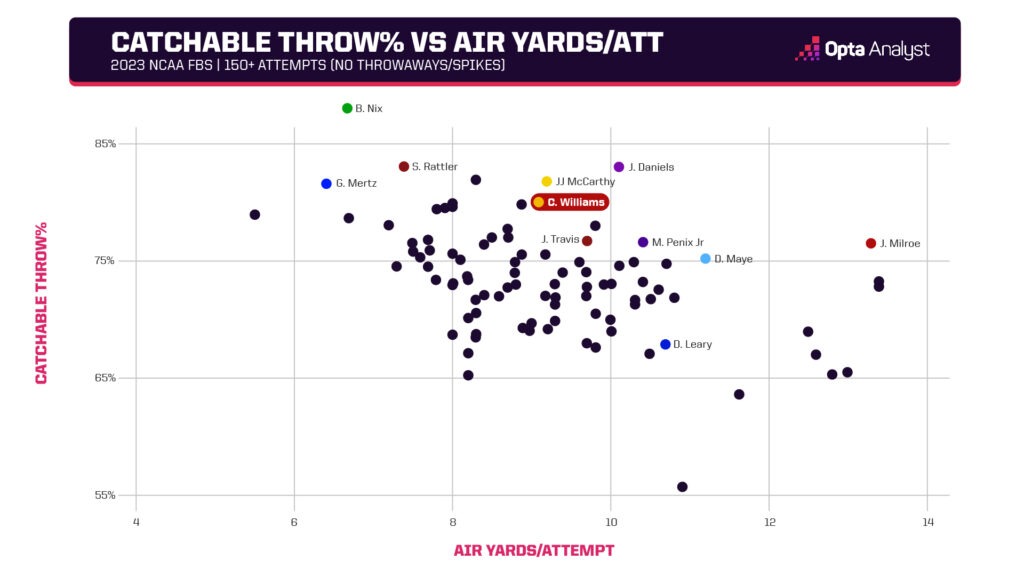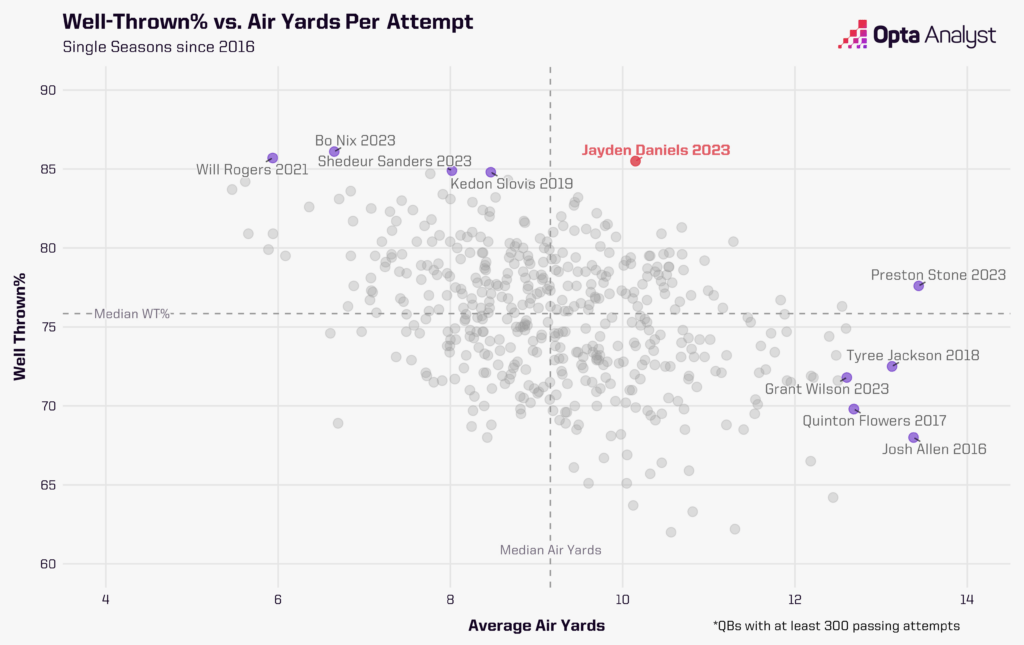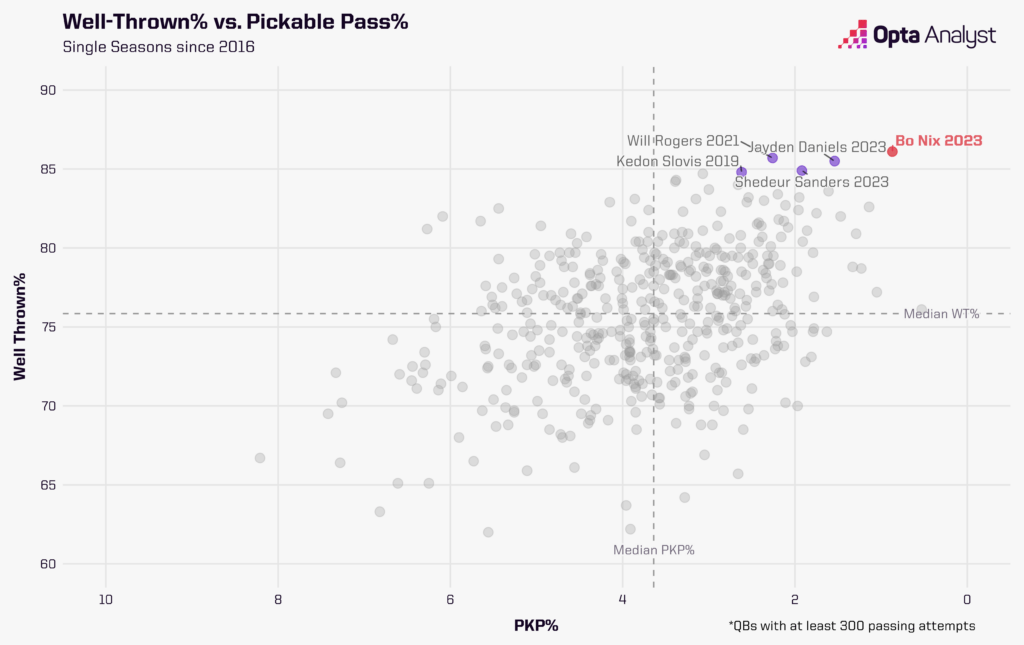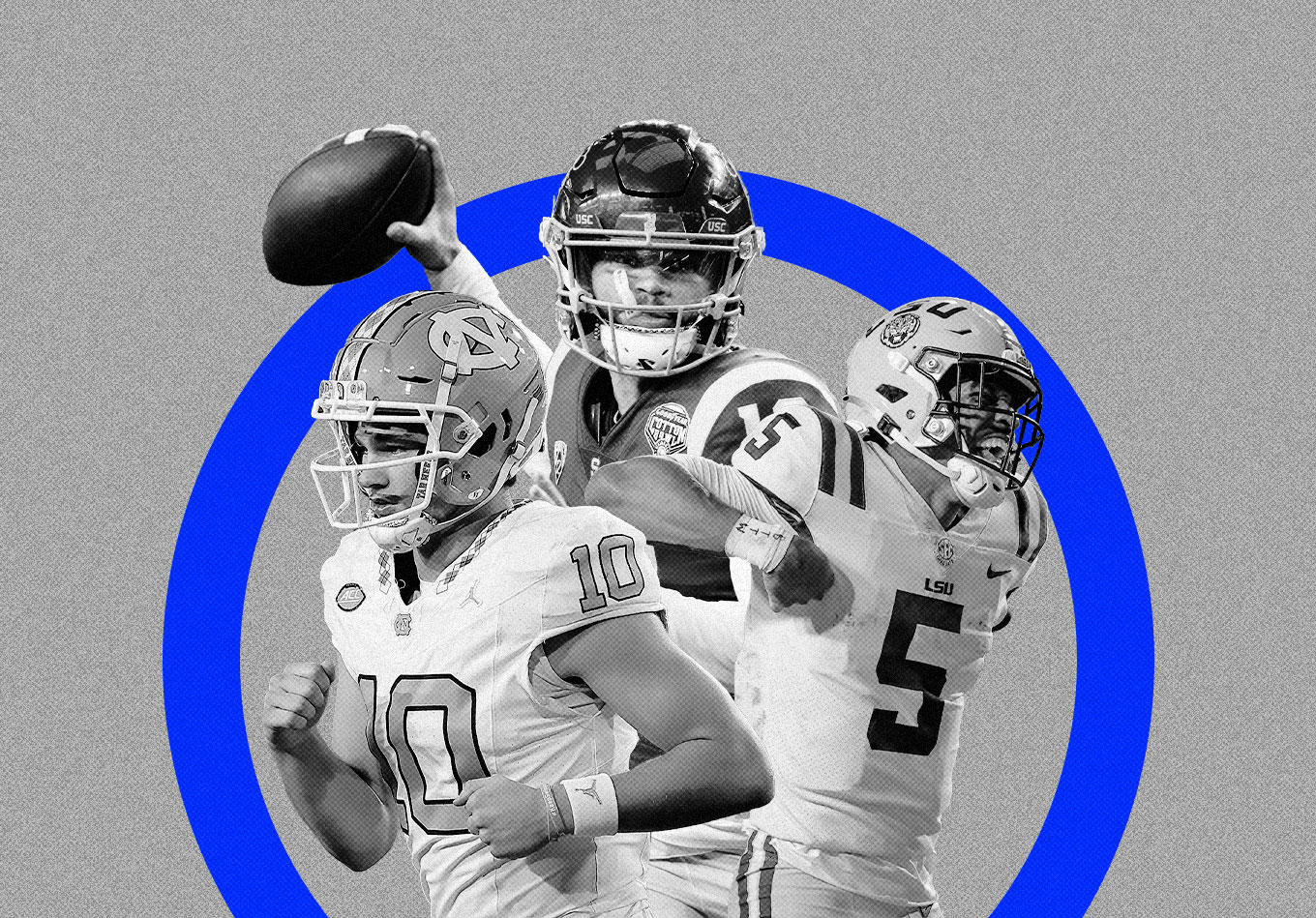This has the makings of a great QB class, but who is the best of the best? With the help of our advanced data, we’re taking a shot at ranking the NFL Draft quarterback prospects.
For obvious reasons, the quarterback position is the one that garners the most attention ahead of any NFL Draft. 2024 will be no exception.
With a group that includes this year’s two CFP national championship starters and each of the past two Heisman winners, there is no shortage of accolades. And pundits tend to believe those accolades will transfer well to the next level.
Rumors have already begun that this could be the first time in NFL history that each of the first four picks are spent on a QB.
This has the makings to be a legendary QB class – but who’s the best of the best within it? Following our rankings on wide receivers and cornerbacks, we use a combination of conventional stats and advanced metrics to rank this year’s QB crop.
1. Caleb Williams, USC
Sometimes, the game is simple. If the football world is comparing you to Patrick Mahomes, you’re probably doing something right. The numbers back this up.
Because Williams finished outside the top 10 in Heisman voting after winning the award in 2022, common fans were led to believe his game dropped off as a junior. But this change in voters’ habits was likely due to “voter fatigue” regarding Heisman winners who return to college, not to mention USC’s team-wide struggles in 2023, losing five games despite ranking third nationally by averaging 41.8 points per game.
Based on the numbers, any supposed decline from Williams was a harsh fallacy.
Williams finished the 2023 season with career highs in completion percentage (68.6), pass yards per attempt (9.4), pass efficiency rating (170.1), and rush TD (11). He simultaneously became the only FBS player since at least 2000 to have multiple seasons with 30 or more passing touchdowns, 10+ rush TDs, and five or fewer interceptions.
This concluded a legendary collegiate career in which Williams, despite only playing three seasons, joined Marcus Mariota as the only FBS players in the 21st century to finish with 10,000+ passing yards, 25+ rush TD, and a 160+ pass efficiency rating.
And when we dive into deeper stats, Williams’ junior year continues to shine. In each of the following metrics, Williams’ last season was his best: open target percentage (82.3%), well-thrown percentage (81.5), catchable throw percentage (80.1) and pickable pass percentage (1.9). He was one of only three FBS QBs (min. 150 “true” attempts, which exclude spikes/throwaways) to finish with 9.0+ air yards per attempt and a catchable throw rate of at least 80% in 2023, joining two other names you’ll see below: Jayden Daniels and J.J. McCarthy.

Does this superhero have an Achilles heel? Yes, as we touched on in our piece breaking down the Bears’ decision in January. Williams’ average time to throw (TTT) of 2.93 seconds was the third highest in the nation in 2023, trailing only Alabama’s Jalen Milroe and CMU’s Jase Bauer – and that was actually the lowest TTT of Williams’ college career.
But the bottom line is that when you have a player with this combination of accuracy, arm strength, mobility, improvisation ability, and consistent production over his three college seasons, the potential is nearly endless.
2. Jayden Daniels, LSU
If these rankings were solely about what each player did in his final college season, Daniels would comfortably be taking the top spot. In fact, he might be taking the top spot in NFL Draft history in that case.
Don’t believe us? If you didn’t glance at our break down comparing Daniels to other recent Heisman winners, here’s a refresher. Daniels set the all-time single-season FBS record in passer efficiency rating with a preposterous value of 208.0, leading LSU to a nation-high 45.5 points per game in the process. He set the power conference record in pass yards per attempt (11.7), and the entire FBS record in yards per play (10.7, which accounts for passes, rush attempts, and sacks). He became the first FBS QB with a 200+ pass efficiency rating and 500+ rushing yards in a season … and he blew past those thresholds with comfort, finishing with 1,134 rushing yards in 12 games.
As the stats become more advanced, Daniels’ senior season continues to be a historic outlier. He was the nation’s only passer to have an 80+ catchable throw percentage while averaging at least 10 air yards per attempt in 2023. He was also this year’s only QB to have a pickable pass percentage under 2.0 while averaging 10+ air yards per attempt.
Stretching to the entire Opta Analyst tracking era (since 2016), he became the only passer with an 85+ well-thrown percentage while averaging 10+ air yards per throw:

The California native was nearly as prolific on the ground, leading all qualified passers in yards per designed run (8.7, min. 50 designed rushes) and yards per scramble (11.5, min. 25 scrambles).
And for good measure, Daniels didn’t share the same weakness as Williams in 2023, either. The NCAA does not record individual sacks taken, but LSU as a team only allowed 22 sacks in 13 games (compared to 34 for USC), and Daniels’ time to throw of 2.60 seconds was much closer to the FBS average of 2.56.
So where does Williams get the edge? For one, Williams’ body of work prior to 2023 was much stronger than Daniels’, as we examined a few weeks ago. And secondly, age is a factor, as Daniels will turn 24 in December of his rookie NFL season.
But if we just look at what we’ve seen the past 12 months, no one in this class – and very few, if any, college players ever – can say they accomplished what Daniels did.
3. Bo Nix, Oregon
At any age level, from Pop Warner to the pros, the two most important traits for any QB are decision-making and accuracy. Nix showcased both at an elite level in 2023.
That’s how the senior put up video-game numbers nearly to the extent that Daniels did last season. Nix set the all-time FBS record in completion percentage (77.4), barely edging Mac Jones in 2020 with Alabama. He led the nation with 45 passing TDs, while simultaneously throwing a meager three interceptions – the most touchdowns ever by an FBS player with three or fewer picks in a season.
It was that ability to avoid mistakes that truly made Nix’s final season spectacular. His pickable pass percentage was a meager 1.08 – lowest in the nation among passers with 200 true attempts. When you combine that with his 87.2% well-thrown rate, also best in the nation this season, you get a blend of accuracy and decision-making that hasn’t been seen in the modern college football world.

This combo of smart choices and strong ball placement led to Nix having a ridiculous catchable throw percentage of 88.3, which is the highest by any player since at least 2016 with at least 150 true attempts:
Catchable Throw Percentage
- Bo Nix, 2023: 88.3%
- Spencer Rattler, 2020: 86.7%
- Tyler Huntley, 2019: 86.4%
- Mac Jones, 2020: 85.0%
- Joe Burrow, 2019: 84.0%
- Baker Mayfield, 2017: 83.8%
Much of this success can be attributed to his 90.9 open target percentage, which also was a single-season record in the Opta Analyst tracking era. Should one choose to hold that against him due to elite coaching, and skill position talent such as Troy Franklin, Tez Johnson, and Bucky Irving? Or should one credit his improved decision-making in his later seasons?
Whatever the more correct answer is to that conundrum, it’s the primary explanation for why his numbers took such a remarkable leap when he transferred from Auburn to Oregon. And if it turns out the latter one is more true, some team will be getting a bargain when Nix falls to them.
4. Drake Maye, UNC
In a field that includes two Heisman winners, one NCAA completion percentage record holder, and two reigning national title game participants, Maye might seem like the odd man out. But it only takes a little bit of film to see what the UNC product is capable of bringing to the table.
If his vertical passing touch is what sticks out, that’s for good reason. Maye ranked eighth among qualified passers with 300.7 pass yards per game in 2023, one year after ranking sixth nationally in the same metric. This largely came due to his ability to stretch the ball downfield, as his 11.2 air yards per attempt ranked 11th in 2023 (min. 150 true attempts). He matched that aggressiveness with accuracy as well, joining Alabama’s Jalen Milroe as the only players with a 75+ catchable throw percentage while averaging 11+ air yards per attempt.
So why isn’t Maye quite as high in this list as many scouts tend to have him? While his top plays were remarkable, he also did display a tendency to force plays that weren’t there. Both his pickable pass percentage and his open target percentage ranked outside the top 30 among QBs with 150+ true attempts nationally – not particularly disastrous rankings in a group of 132 QBs, but not quite at the level of the three passers mentioned above him.
Still, with his sheer athletic tools, combined with his youth relative to much of his class (not turning 22 until August), he’s easily capable of proving this list wrong.
5. Michael Penix Jr., Washington
There might not be a QB prospect in the history of the NFL Draft whose pros and cons were as obvious as Penix’s. The primary cons are his age (turning 24 in May), and his injury history, which includes two ACL tears and two-season ending shoulder injuries during his college career alone.
The pros? He can put the ball wherever the hell he wants.
The display he put on in a win over Texas in the CFP semifinals was an absolute masterclass in ball placement. But all season long, his bread and butter was making difficult throws in a way that no one else truly could.
Penix finished as the nation’s leader with 4,903 passing yards, while also ranking third with 36 pass TDs behind Nix and Daniels. And those gaudy counting stats did not come easily. Penix was never afraid to air it out downfield, averaging 10.4 air yards per attempt in his final season. More often than not, he managed to put the ball exactly where it needed to be. Penix was one of four passers to have a 75+ catchable throw percentage while averaging at least 10 air yards per attempt, joining Daniels, Maye, and Milroe.
Beyond the aforementioned age and health concerns, one knock on Penix is that this aggressive style led to some turnovers, with his 11 interceptions being far ahead of Daniels’ four, Nix’s three, or Williams’ five. But even with that, Penix ranked fifth nationally in total Expected Points Added (via CollegeFootballData.com), as the face of Washington’s remarkable season.
He has a particularly wide range of possible outcomes given the possible pitfalls, but it’s impossible not to be enamored by his ceiling.
6. J.J. McCarthy, Michigan
How much does winning matter? That’s the million dollar question surrounding McCarthy’s Draft stock.
The junior was as successful as one could possibly be in the one metric that each QB cares the most about, leading Michigan to its first national championship of the 21st century with a 15-0 season in 2023. Over the course of his career, his 27-1 record as a starter was the best by any FBS QB (min. 20 starts) since Toledo’s Chuck Ealey won all 35 of his career starts from 1969-71 (yes, that actually happened).
As it pertained to individual statistics, McCarthy was also impressive in his final season. While McCarthy was already one of the nation’s better QBs when he led the Wolverines to a Big Ten title in 2022, he raised his game even more as a true junior. His pass efficiency rating (167.4), completion percentage (72.3), and pass yards per attempt (9.0) all blew his 2022 numbers out of the water (155.0, 64.6, and 8.4, respectively), with each of the first two falling in the top 10 nationwide. He also ranked third nationally behind Daniels and Nix in ESPN’s “QBR” metric.
The advanced metrics weren’t quite as nice to him, but he was one of three passers to have an 80+ catchable throw percentage while averaging at least 9.0 air yards per attempt, joining Williams and Daniels. More importantly than that, though, the biggest criticism of McCarthy has been that the Wolverines didn’t trust him the same way that other teams did with the QBs on this list. In Michigan’s five closest games (Penn State, Maryland, Ohio State, and the two CFP games), McCarthy only totaled 96 pass attempts (19.2 per game), never having more than 27 in any of them.
The counter to that is that McCarthy always did what he needed to do, and when your rushing attack led by Blake Corum and Donovan Edwards averages 169.1 yards and 2.7 touchdowns per game over the course of a season, you don’t always need to do very much. In the pros, where McCarthy likely will be joining a team that was under .500 last season, that won’t be the case.
But McCarthy, who only turned 21 in January, clearly has strong athletic tools and an elite winning pedigree to match, making him very capable of living up to his rapidly rising Draft stock.
The Next Tier
- Spencer Rattler, South Carolina (second in FBS with 83.2% catchable throw rate in 2023, behind Nix)
- Jordan Travis, Florida State (one of two QBs with 20+ pass TDs and two or fewer INTs in 2023, along with Drew Allar)
- Sam Hartman, Notre Dame (15th in FBS with 159.5 pass efficiency rating in 2023)
- Michael Pratt, Tulane (16th in FBS with 158.9 pass efficiency rating in 2023)
Check out our MLB, NBA and NFL coverage, as well as our college basketball picks. Follow us on X and Instagram for more!
